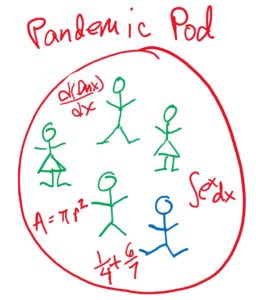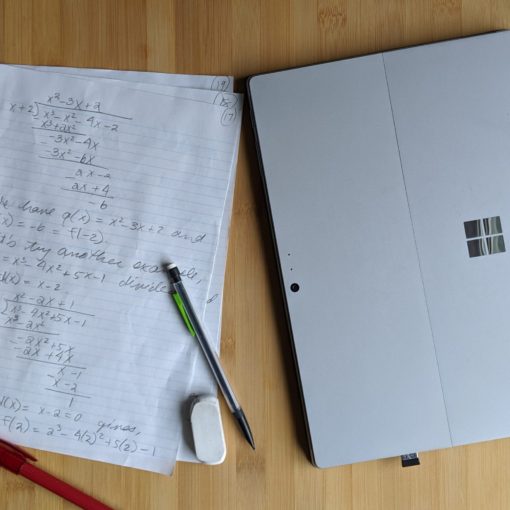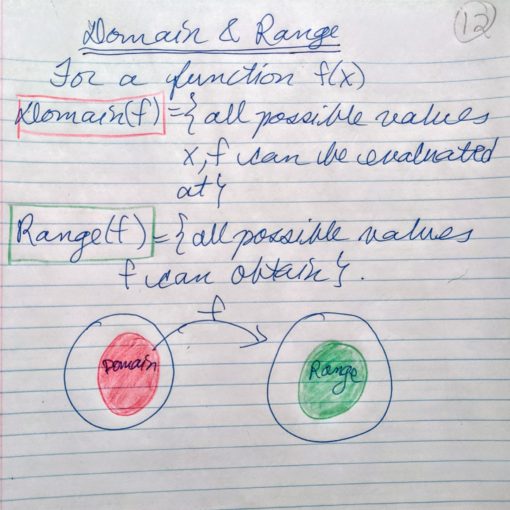
I am not normally a huge fan of the news. It always seems the most horrible things are going on in the world but I can’t believe everything is horrible out there. However, since the Covid-19 era started, I have started browsing through the news each morning. A lot of it hasn’t been terrible good for the longest time. I’ll go through the, headlines, skimming through parts of some articles, looking for quality writing, valuable content, inconsistencies for fun. One morning I can across an article with the terms pandemic pod and tutoring in it. I found it interesting because we’re here to tutor and offer help and resources to parents, students, teachers and anyone learning or instructing mathematics. I wanted to know what these pandemic pods were. Maybe it was something new?
What is a pandemic pod?

A pandemic pod is a “bubble”, another word that has come into the Covid-19 era vocabulary to mean the people that socialize with regularly that are within that 2 metre radius of you, in which you and your pod mates study and learn together. Who you choose to be in your pod is up to you but you don’t change those pod mates. One of the members of the pandemic pod is someone who facilitates the learning in that pod. This pod facilitator can be a tutor, or parent but someone who you and the other pod members feel comfortable with. They become a regular pod member.
How can these pods be created?
- Within a family, if there are many children in the household.
- Through friends of the family and children in the family that members of the family have already been exposed to regularly.
- By grade. For younger children at the elementary school level, K – Grade 8, since everyone in a grade study the same subjects and material, this may work well. It isn’t until students reach high school that students in the same grade can choose different subjects and be studying the same subject at different levels. g. applied math vs advance math
- By subject. For high school students this may work better. If there are a couple of children in a family all in high school but at different levels, bringing in one tutor or educator, they would be able to handle a subject at any level rather than multiple subjects. One child may have friend in the same grade level all taking the same subject and level so they would be learning the same material. Bringing in one pod facilitator to help with that subject and level would make it easier on everyone in the pod, financially and logistically.
- By neighbourhood. If there are a few people living on the same street or neighbourhood with children around the same age, this would geographically make it easier to coordinate.
There are many ways a pandemic pod can be created. Finding the way that works for you, your children’s lifestyle and needs is what is important.
Questions to consider once you have a pod.
Who is going to be the pandemic pod facilitator?
That’s a good question. So many parents, while still working from home, don’t have the time or patience or temperament to juggle “homeschooling” duties with their work duties. So, an outsider may be the answer. This is where making the decision to bring someone into the pod physically or virtually comes in.
- Parent
- Friend of the pod members
- Outside tutor
- Everyone in the group each take turns or collectively facilitate the pandemic pod and the learning.
After the experience of online learning during the spring of 2020, many have decided they learn better in person. This may be the case. However, who the outsider is interacting with needs to be considered, and the outsider will also consider who the pandemic pod members are interacting with. If everyone is comfortable with bringing in an outsider to physically come into their pandemic pod, that’s great. At that point, the screening on both sides for the tutor and the pod members would have to be mutually agreed upon. The other alternative is to give virtual learning a try again, but this time it would be with a tutor that is motivated and accepting of the online learning tools and platforms. This is where considering the differences between a tutor and a certified, teacher in a school come in. That’s another post! But definitely worth a read.
Types of pandemic pods
- Virtual – students with some common element, mostly likely subject, meet online with a tutor and learn a topic or lesson and work on problems and examples together. After which each student goes and does their own homework and review. Very much like a school classroom except now we have a much smaller class size with a group of friends, so like minded individuals, with a tutor that everyone is developing a connection with and tutor that has an invested interest in developing a connection with the students and families.
- In person – same as the virtual situation except now everyone agrees to meet at a common location in person.
- Combination of in person of virtual – This may include students meeting in person and working with a tutor online together; or a group of students meeting up, like a study group, and learning on their own together using online resources. Now the entire group is a pod facilitator
There are many reasons why a pandemic pod for learning and tutoring may be of value.
Benefits of pandemic pod learning
Real life is full of little groups or pods working and learning together towards a common goal. Pandemic pods are great experience and training for this. University and college students usually use this method for getting through school.
Students will learn to work together. It’s too easy for students in school to go through school never really working together with their peers unless it’s for a group project.
It provides a situation where students now have to find a way to teach themselves. Most students that go to school just accept that being in school means they are learning. Not the case as so many report cards indicate!
The classroom setting and curriculum outlines and timelines for learning subjects don’t necessarily suit all students and their abilities and learning styles. This is an opportunity for students that don’t thrive in a classroom setting and methodology of learning to find their own way to get to the same end result and thrive doing so.
Schedules can be adjusted to suit the student optimal times for learning. Too many schools operate during those traditional hours of 9-3:30 give or take an hour here and there. With a schedule lunch hour. But, not everyone has the same body clock and as kids are growing, they may need rest, recharging and refueling at times other than those that are imposed by a rigid in person, brick and mortar school system.
Having a tutor teach material can be fresh. Many certified teachers end up teaching one way. Those working or having worked in a school may have taught the same subject for years and years, even the same grade. That can result in the same thought patterns and as a result, not as fresh an approach. A tutor that teaches a variety of either subjects of grade levels will without a doubt have a fresh approach because in a day, they will have probably interacted with a many different levels of a subject.
Costs are shared among many participants which is great. Expect the rate per hour for a tutor to work with a pod to be greater because they are now having to address more and different challenges but it’s still savings in the long run.
Cons of a pandemic pod
There are not too many that I can see except for when in person.
- In person pandemic pods do run the risk of someone bringing the virus in and then everyone else becoming infected. This is the biggest risk. It can be mitigates by practicing safe social distancing when the pandemic pod meets in person.
- When a teacher is teaching in class, it does happen occasionally that the teacher will introduce new topics or material or examples that aren’t covered in the textbook. Something I have noticed when tutoring is that some teachers love using handouts to supplement the textbook. In some cases, the teacher doesn’t even provide a textbook and just using handouts they create and provide. This can be overcome quite easily. Constant communication with the teacher and/or class to get the most current material can easily overcome this.
- Depending on how large the pandemic pod is, there is the social side of things. A large part of the school experience is social. While there quite a bit of social going on that is not in person, there are many aspects of social behaviour that cannot be experience unless you are in person. This a big con and one that is hard to overcome unless some risk is taken to interact in person.
At Raise my marks math tutoring and exercises can definitely help you put together a pod or help you develop one, whether it’s the logistics, communication within the pod or facilitating the pod. If you have any questions or are sure if a pandemic pod is for you, or private tutoring, give us a call and we’ll be happy to sit and discuss your options. It’s a tough decision especially in these uncertain times. The future of a generation is dependent on it!
References
- Some parents are choosing ‘pandemic pods’ over sending children back to school, Brooklyn Neustaeter, July 30, 2020, CTVNews.ca, URL: https://www.ctvnews.ca/canada/some-parents-are-choosing-pandemic-pods-over-sending-children-back-to-school-1.5045142
- Parents turn to pandemic pods for back to school, Leah Larocque, August 6, 2020, Ottawa.CTVnews.ca, URL: https://ottawa.ctvnews.ca/parents-turn-to-pandemic-pods-for-back-to-school-1.5054309?cache=%3FclipId%3D89830
- Pandemic pod warning: Parents should be aware of these potential dangers, Melanie Woodrow, August 5, 2020, abc 30 Action News, URL: https://abc30.com/pandemic-pods-distance-learning-are-kids-going-back-to-school-california-coronavirus/6355882/
- How to Form a Pandemic Pod, J.A. Smith and W. Winters, July 15, 2020, Greater Good Magazine, URL: https://greatergood.berkeley.edu/article/item/how_to_form_a_pandemic_pod
- Canadian parents are setting up ‘pandemic pods’ during coronavirus: what are they?, Katie Dangerfield, August 4, 2020, Global News, URL: https://globalnews.ca/news/7221624/coronavirus-education-learning-pandemic-pods-canada/
- The pandemic is fueling the private tutoring industry, Terry Nguyen, Aug 6, 2020, Vox, URL: https://www.vox.com/the-goods/2020/8/6/21354637/pandemic-learning-pods-private-tutoring
- Coronavirus: How pandemic pods are zutors and changing home-schooling, Penny Spiller, August 4, 2020, BBC News, URL: https://www.bbc.com/news/world-us-canada-53622214
- Rise of ‘Zutors’: private Zoom tutors spark controversy as virtual school year looms, Mario Koran, July 23, 2020, The Guardian, URL: https://www.theguardian.com/education/2020/jul/23/schooling-children-coronavirus-tutors-zoom




